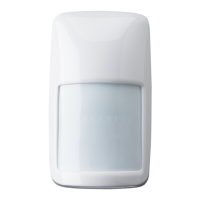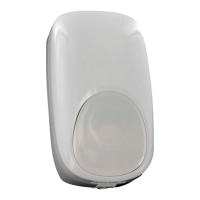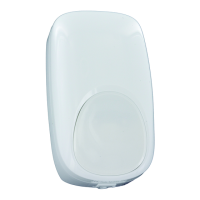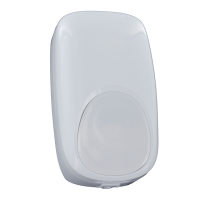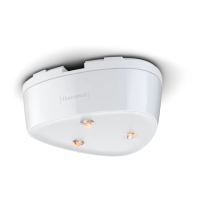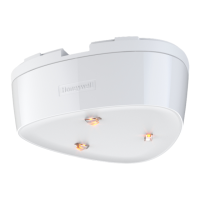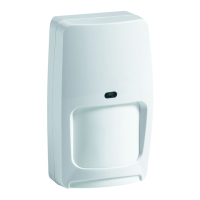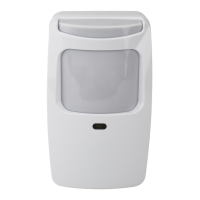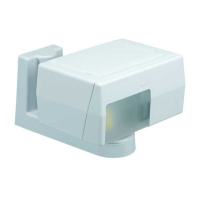- 4 -
RELAY OPERATION
1
For information on Trouble conditions, see the Troubleshooting section.
TROUBLESHOOTING
*TROUBLE CONDITIONS:
1
Self-Test Failure conditions:
• Microwave supervision failure: The sensor is operating in PIR mode only.
• PIR self-test failure: The sensor is disabled.
• Temperature compensation failure: The temperature compensation is
disabled.
Depending on the Trouble condition, take the following corrective actions:
• Verify the power supply is sufficient (at least 9V at the sensor).
• Cycle power to the sensor.
• Walk test the sensor.
If the Trouble condition does not clear, replace the sensor.
SPECIFICATIONS
Range: 40’ x 60’ / 12 m x 20 m
Power: 9.0 - 15 VDC; 15 mA typical, 17 mA maximum, 12 VDC;
AC Ripple: 3 V peak-to-peak at nominal 12 VDC
Alarm Relay: Energized Form A; 30 mA, 25 VDC, 22 Ohms resistance
maximum. Alarm Relay Duration: 3 seconds
Tampers: Cover & Wall; (NC with cover installed) Form A;
30 mA, 25 VDC
Microwave Frequencies: 10.525 GHz
RFI Immunity: 20V/m 10-1000MHz, 15V/m 1000-2700MHz
PIR White Light Immunity: 6,500 Lux typical
Fluorescent light filter: 50 Hz / 60 Hz.
Operating Temperature: 14° to 131° F / -10° to 55° C
Relative Humidity: 5 to 95%; non-condensing
Temperature Compensation: Advanced Dual Slope
Dimensions: 4.57” H x 2.76” W x 1.69” D /
9.8 cm H x 5.7 cm W x 4.35 cm D
Weight: 3.6 oz / 102 g (net weight)
ACCESSORIES
SMB-10
(P/N 0-000-110-01)
Swivel Mount Bracket
SMB-10C
(P/N 0-000-111-01)
Swivel Mount Ceiling Bracket
SMB-10T
(P/N 0-000-155-01)
Swivel Mount Bracket w/Tamper
DT8-G2 Lens Kit
(P/N DT8G2LENS5PK)
Replacement Fresnel Lens Kit – 5
Pack
APPROVAL / LISTINGS:
• FCC part 15, Class B verified
• IC ICES-003, Class B verified
• UL 639
• ULC S306-03
• SIA-PIR-01 Passive Infrared detector standard features for
false alarm immunity.
Product must be tested at least once each year.
For appropriate wiring methods, refer to the National Electrical
Code NFPA 70 and the Canadian Electrical Code (where
applicable).
Power must be provided by a power-limited UL603 Listed
burglar alarm power supply with minimum 4 hours of standby
power capability, or from a power-limited output of a UL Listed
burglar alarm control unit with minimum 4 hours of standby
power capability.
Accessories not evaluated by UL. For UL applications, enable
look down and disable pet immunity.
For the latest documentation and online support information, please go to:
http://www.security.honeywell.com/hsc/resources/MyWebTech/
For the latest U.S. warranty information, please go to: www.honeywell.com/security/hsc/resources/wa or
Please contact your local authorized Honeywell representative for product warranty information.
2013 Honeywell International Inc. Honeywell and DUAL TEC are registered trademarks of Honeywell International Inc.
All other trademarks are the properties of their respective owners. All rights reserved. Made in China.
P/N 800-16553 12/13 Rev A
2 Corporate Center Drive, Suite 100
P.O. Box 9040, Melville, NY 11747
www.honeywell.com/security
FEDERAL COMMUNICATIONS COMMISSION STATEMENTS
The user shall not make any changes or modifications to the equipment unless authorized
by the Installation Instructions or User's Manual. Unauthorized changes or modifications
could void the user's authority to operate the equipment.
CLASS B DIGITAL DEVICE STATEMENT
This equipment has been tested to FCC requirements and has been found acceptable for
use. The FCC requires the following statement for your information:
This equipment generates and uses radio frequency energy and if not installed and used
properly, that is, in strict accordance with the manufacturer's instructions, may cause
interference to radio and television reception. It has been type tested and found to comply
with the limits for a Class B computing device in accordance with the specifications in Part
15 of FCC Rules, which are designed to provide reasonable protection against such
interference in a residential installation. However, there is no guarantee that interference will
not occur in a particular installation. If this equipment does cause interference to radio or
television reception, which can be determined by turning the equipment off and on, the user
is encouraged to try to correct the interference by one or more of the following measures:
• If using an indoor antenna, have a quality outdoor antenna installed.
• Reorient the receiving antenna until interference is reduced or eliminated.
• Move the radio or television receiver away from the receiver/control.
• Move the antenna leads away from any wire runs to the receiver/control.
• Plug the receiver/control into a different outlet so that it and the radio or television
receiver are on different branch circuits.
• Consult the dealer or an experienced radio/TV technician for help.
INDUSTRY CANADA CLASS B STATEMENT
This Class B digital apparatus complies with Canadian ICES-003.
Cet appareil numérique de la classe B est conforme à la norme NMB-003 du Canada.
FCC / IC STATEMENT
This device complies with Part 15 of the FCC Rules, and RSS210 of Industry Canada.
Operation is subject to the following two conditions: (1) This device may not cause harmful
interference, and (2) This device must accept any interference received, including
interference that may cause undesired operation.
Cet appareil est conforme à la partie 15 des règles de la FCC & de RSS 210 des Industries
Canada. Son fonctionnement est soumis aux conditions suivantes: (1) Cet appareil ne doit
pas causer d’interférences nuisibles. (2) Cet appareil doit accepter toute interférence reçue
y compris les interférences causant une réception indésirable.
↑ Top
↑ Top

